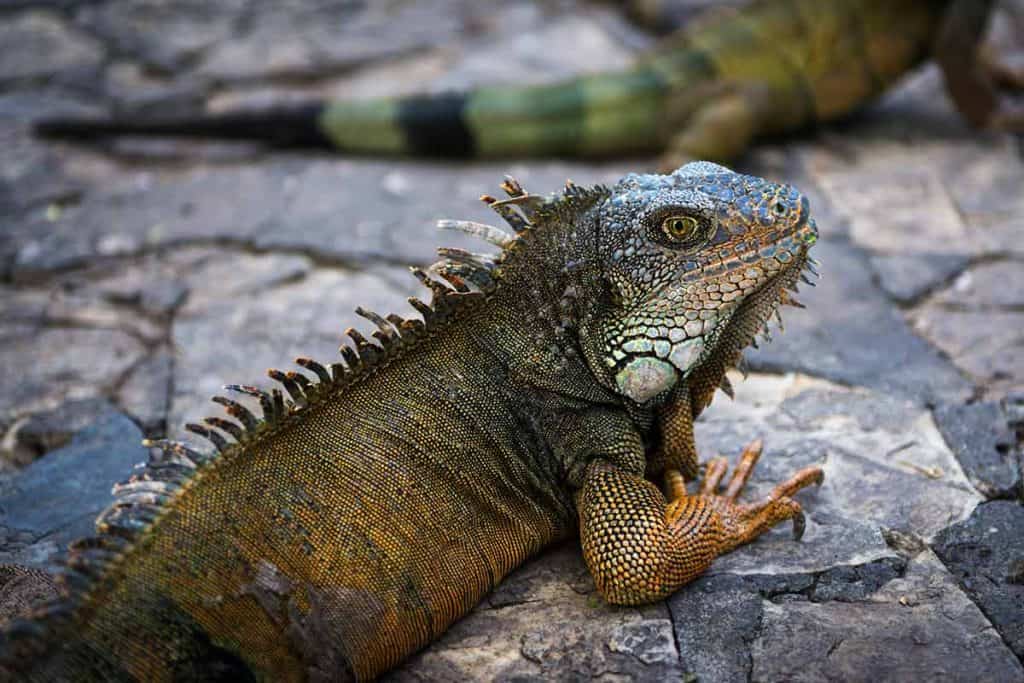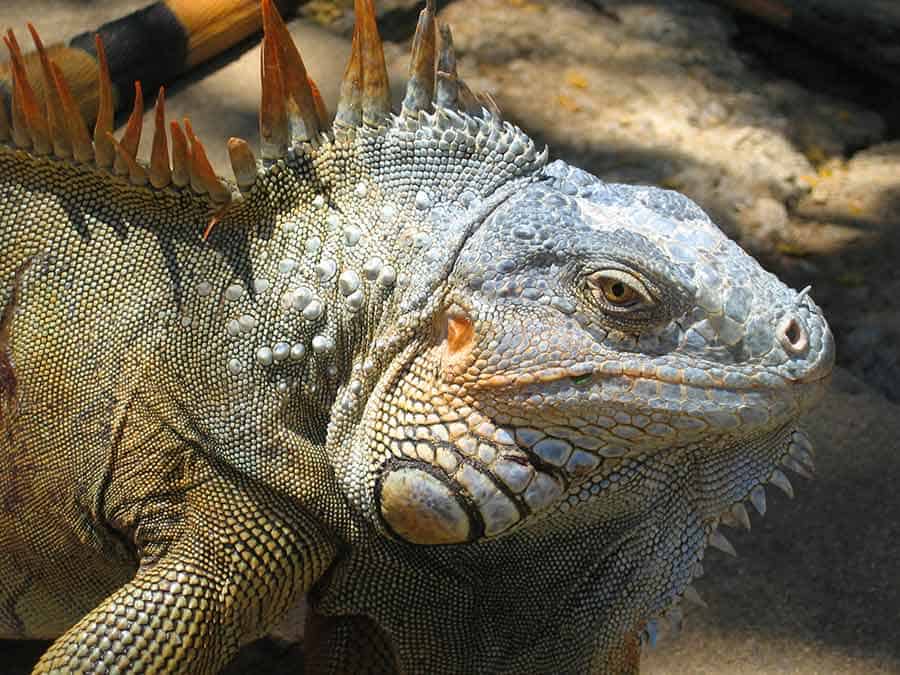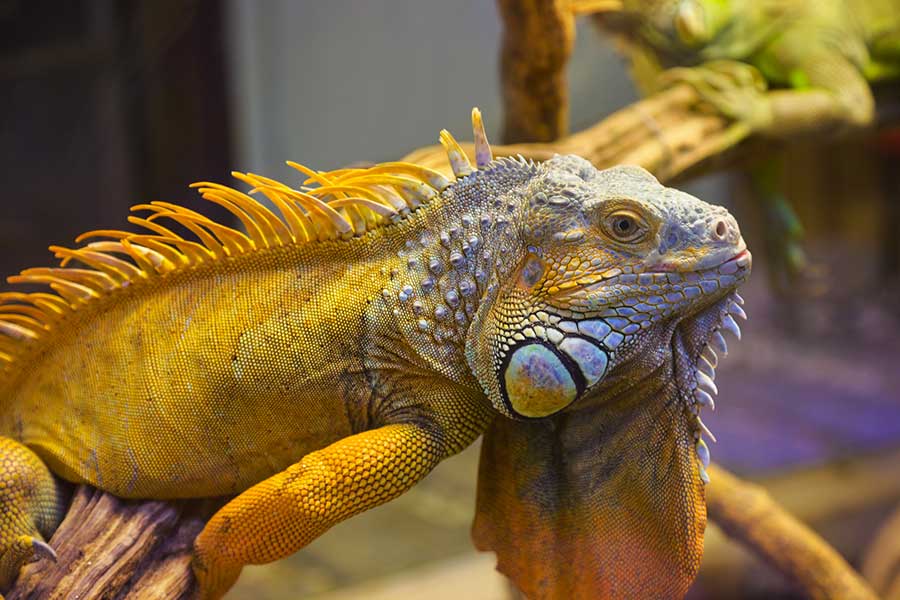Originally from tropical areas of Central America, South America, the Caribbean, and Mexico, the iguana is a very popular pet lizard. However, managing proper iguana care can be hard, since these lizards grow up to six feet long, have a long lifespan, and can be difficult to handle because they are so large and strong. And that’s just the beginning!
Due to their sheer size, iguanas have specific housing requirements and need large enclosures to stay happy and healthy. Their need for space is so big that some owners opt to convert an entire room into an iguana habitat rather than build or purchase a custom enclosure.
These arboreal lizards can be a challenge to tame, and they can easily become aggressive if not handled regularly from a young age. However, this isn’t to say that they can’t make wonderful pets. In the hands of an owner who understands their needs and is willing to put in the effort necessary for caring for an iguana, these lizards make amazing, curious, friendly, and intelligent pets.
Read on to find out how to properly care for an iguana and learn about their unique husbandry and dietary requirements!
How to Care for an Iguana: Basic Shelter
Despite their gigantic size and intimidating appearance, green iguanas are one of the best lizards for handling if socialized properly from a young age. Unlike many other reptiles like bearded dragons and leopard geckos, iguanas are diurnal species, which means they are the most active during the day. This allows owners to observe their scaly pets as they bask in the heat and climb logs and other tank decorations.
However, unlike other lizards who may be forgiving if their habitat isn’t just right, iguanas have fairly strict housing, feeding, and care requirements. For a green iguana, the lack of proper husbandry can lead to health problems and sometimes even premature death.
The average lifespan of an iguana is from 12 to 15 years, but they can easily live for more than 20 years when properly cared for. To ensure that your iggy reaches ripe old age, here are the things you need to pay attention to when it comes to their care needs.
Enclosure Size and Setup
As I’ve said before, iguanas can grow to be over six feet long from the tip of their nose to the tip of their tail. Females are generally smaller than males, however, and are rarely over five feet long. Adult iguanas can weigh anywhere from 11 to 20 pounds, which is equal to the weight of some small breed dogs!
This giant size is often a big surprise for many owners who start with a tiny baby iguana. An adult iguana needs much more space than other popular pet lizards like geckos and beardies. These types of commercial enclosures may only work as a short-term solution for a baby iguana and will be outgrown in a few months.
Truth be told, most commercially made enclosures aren’t large enough to meet an adult iguana’s space needs. Thus, most owners decide to either make their own enclosures or purchase a custom-built enclosure combined with all accoutrements an iggy needs to stay happy and thrive.
An adult iguana’s tank should be at least around 12 feet long, 8 feet high, and 6 feet wide. This is a minimal requirement for a single adult iguana, and bigger is always better.
Due to their substantial need for space, many owners choose to convert a larger closet or an entire room into an enclosure for their iguanas. If you don’t have an empty room that can serve as your pet’s home, you can opt to make a custom-built enclosure using materials like wood, plexiglass, or mesh.
Unlike other beginner lizards for newbie herpers, iguanas shouldn’t live in glass terrariums, as they lack ventilation. These types of tanks can become extremely humid and moldy if not properly ventilated and cleaned every day.
Temperature
Iguanas are tropical species, and their habitat needs to mimic their natural environment as closely as possible. Like other lizards, iguanas also prefer a thermal gradient or range of temperatures inside their enclosures so they can adjust their body temperature according to their liking by simply moving around in the enclosure.
The ambient temperature inside the iguana enclosure should be around 85 to 90 degrees Fahrenheit. Iguanas like to bask, so you’ll need to keep their basking area at around 95 to 105 degrees Fahrenheit. The enclosure should also have a cool side that won’t exceed 80 to 85 degrees Fahrenheit.
Heat is very important for iguanas since it supports healthy growth and digestion. Without an appropriate thermal gradient, your iguana can become sick and die.
Avoid any type of under-tank heating mats, as they can burn your iguana’s sensitive feet and belly. Located on top of their heads, iguanas have a third eye, which they use to regulate their body temperature. Since this primitive “eye” is on top of their heads, iguanas can’t notice the heat sources underneath them, which can lead to severe burns if you decide to use under-tank heating devices.
To achieve the perfect temperature for the basking area, use heat lamps that are generally positioned less than a foot from the basking spot. Make sure to read the manufacturer’s guidelines for using that particular right to achieve an ideal temperature.
Depending on the size of the enclosure, you may need up to six heating fixtures, either infrared bulbs or ceramic heat emitters, to ensure that the basking area is large enough to heat up your iguana’s entire body. To maintain the ideal temperature at night, you should use ceramic heat lamps or red or purple lights that won’t disrupt your iguana’s circadian cycle.
Lighting
Besides appropriate temperature, your iguana will also need proper lighting. Use UVB bulbs made specially for reptiles to ensure your iguana is getting ideal levels of light every single day. As diurnal species, iguanas need a full photocycle of around 12 hours of light and 12 hours of darkness each day.
Making sure that your iguana gets enough light every day stimulates hormone production and regulation, thus ensuring the overall health of your pet. Also, this mimics the natural benefits your iguana would get from basking in natural sunlight, mainly when it comes to vitamin D production. Without sufficient levels of UVB light, iguanas can develop metabolic bone disease, which can lead to weakness and bone fractures.
For large enclosures and rooms, you can use mercury vapor bulbs, while tubes and compact fluorescent lights can be used for smaller enclosures. Being an arboreal lizard, your iguana will climb trees and decorations inside its tank and bask in these lights, getting all the vitamin D it needs.
Humidity
As tropical lizards, iguanas are used to higher humidity levels than desert-dwelling reptiles. When setting up your iguana’s enclosure, humidity is another important factor to consider, as it is necessary for the health and wellbeing of your pet lizard.
Iguanas like it steamy, and the ideal humidity levels for an iguana enclosure are around 70% to 80%. This kind of humidity can be hard to achieve without consistent misting and a high ambient temperature.
To maintain humidity inside your iguana’s habitat, add a pool of water inside the enclosure and consider investing in a commercial misting system. You can increase the humidity inside the enclosure and keep your iguana’s skin healthy and hydrated by misting your pet two to three times a day.
Don’t forget to use a hydrometer to measure the humidity levels inside the tank and make sure they are in the optimal range. Otherwise, there is a chance that you won’t notice when and if the humidity is out of range, which can cause your iguana to become sick.
Substrate
When searching different substrates for your iguana, you’ll soon discover that the choice of bedding isn’t as easy as it seems. This is mainly because ingesting certain indigestible loose substrates can cause impaction in reptiles. Keeping that in mind, many people decide to use reptile carpets, towels, tiles, or shredded newspaper as a substrate for their iguanas.
Generally speaking, baby and juvenile iguanas are at a higher risk of getting impaction, so you should line their enclosure with reptile carpet or paper towels. Adult iguanas, on the other hand, don’t burrow and spend most of their time climbing, so they can live happily on coconut fiber, cypress mulch, or bio-active substrate.
Regardless of whichever type of substrate you decide to choose, you’ll need to spot clean it every day to maintain hygiene inside the enclosure. Since iguanas are large reptiles, they can create a lot of mess, so scooping poop and plant debris via spot cleans will be a daily occurrence.
Once a week, clean the entire enclosure using a reptile-friendly disinfectant and replace the entire substrate. While cleaning, you should place your iguana into another tank and return it only after you’ve finished cleaning the entire enclosure.
Decorations
Learning how to care for an iguana wouldn’t be complete if you didn’t know what type of decorations iguanas need inside their enclosures. When decorating your iguana’s enclosure, your goal should be to replicate their natural habitat as much as possible.
Since iguanas are arboreal lizards, they need a lot of climbing surfaces! This means you’ll need to add perches, thick branches, logs, and ramps. This way, your pet lizard will have plenty of surfaces to climb on and explore during the day.
You can also select live, iguana-safe plants to create natural hiding places and spots where your pet can retreat to.
Please note, since most live plants are sprayed with all sorts of pesticides, you should spray them with water and leave them outside in the sun for at least two weeks. When those two weeks are up, you use the live plants to decorate your iguana’s enclosure without worrying about harmful chemicals.
Food & Water Requirements
Due to their large size, a lot of people assume that iguanas are insectivores, but that’s not the case. In the wild, iguanas are strict herbivores, which means they only eat fresh plant matter. The ideal diet for an iguana should consist of around 90% plant matter, such as greens, other vegetables, and flowers, and 10% fruit.
Iguanas should never eat meat, insects, dairy, or other human foods. In fact, eating protein can cause serious health problems, like kidney failure in iguanas.
The good news is you won’t have trouble finding food for your iguana, as almost everything your pet eats can be easily found in all local supermarkets. Ideally, you should feed your iguana a variety of dark and light leafy greens, including black mustard seed, broccoli, kale, collard, and romaine lettuce, to name just a few.
Iguanas can also obtain valuable nutrients by eating all sorts of vegetables like green beans, carrots, and squash. These lizards also love fruit, but should eat it sparingly, once or twice a week, as too much fruit can cause diarrhea. Fruit is also fairly high in oxalic acid, or oxalates, which interferes with
When feeding your iguana, you’ll need to sprinkle high-quality
When preparing meals for your iguana, you should remember to steer clear of certain foods that are high in oxalates. Spinach and parsley, for example, are high in oxalates that, as stated earlier, can affect the
Furthermore, certain water-dense foods like iceberg lettuce and cucumbers are best avoided since they don’t have much nutritional value.
The thing that surprises most new owners is that iguanas tend to swallow their food whole without chewing. This means that you’ll need to cut everything you offer to your iguana into bite-sized pieces to make sure your pet eats the entire meal. If you have a baby or juvenile iguana, everything will have to be shredded and chopped into even smaller pieces.
In addition to regular, fresh, and varied meals, your iguana will also need access to fresh and clean water at all times. In the wild, iguanas usually live close to water, so it’s up to you to ensure that your scaly pet has to clean water.
To keep your iguana hydrated, you need to mist them daily and soak them at least twice a week inside a large water dish, sink, or bath. If possible, it is best to provide two separate water dishes in your iguanas enclosure: one small one for them to drink from, and a much larger, deeper one for them to soak in.
FAQs About Iguana Care
Are iguanas good pets for beginners?
Iguanas are not good pets for beginner keepers or children, as caring for them requires extensive experience, knowledge, and skill. Iguanas have specific care requirements, and owners must know how to regulate temperature and maintain ideal humidity levels inside their enclosures.
Furthermore, iguanas must be handled and socialized from a young age; otherwise, they can become aggressive and even try to bite or tail whip their owners. A beginner owner might have trouble taming such a large lizard and may even end up injured in the process. Also, iguanas need a lot of space, and setting up their massive, elaborate enclosures is often too challenging for first-time reptile keepers.
What size tank do iguanas need?
Baby and juvenile iguanas can live comfortably in a 20 to 40-gallon tank. However, as they grow, this type of enclosure will quickly become too small, and you will need to relocate your iguana into a much larger enclosure. 12 feet long by 8 feet high and 6 feet wide is a minimal enclosure size for an adult iguana, and larger is always better.
Because they are capable of growing up to 7 feet long and weighing up to 20 pounds, adult iguanas occupy a lot of space and need more room to move around, climb, and explore.
What do you need for a pet iguana?
Iguanas are large-sized tropical reptiles that have specific husbandry and dietary requirements.
To take care of an iguana, you will need a large enough enclosure, safe substrate, live plants, and decorations, including tree branches and perches for your iguana to climb on. Additionally, you’ll need to provide 12 hours of lightning using appropriate UVB levels.
As a tropical reptile, green iguanas are used to high levels of humidity, so you’ll need to mist your reptile daily and consider investing in a commercial misting system. Last but not least, you’ll need to use heat bulbs to maintain the temperature inside the enclosure and create a thermal gradient and a basking spot for your iguana to stay healthy and happy.
A Final Word on Iguana Care
While they are popular reptiles to own, iguanas are moderately hard to care for and aren’t a good choice for newbie keepers. There are a lot of things to consider and keep in mind when it comes to iguana care. Unlike some pet reptiles, iguanas have very specific dietary and care needs that have to be met for them to stay happy and healthy.
First of all, iguanas can’t live in a standard
Without proper husbandry, iguanas can easily become sick and die. So, unless you are completely sure that you can meet the extensive needs of your pet lizard, don’t commit to an iguana. There are many interesting reptiles that are easier to keep and make much better pets for first-time owners.




